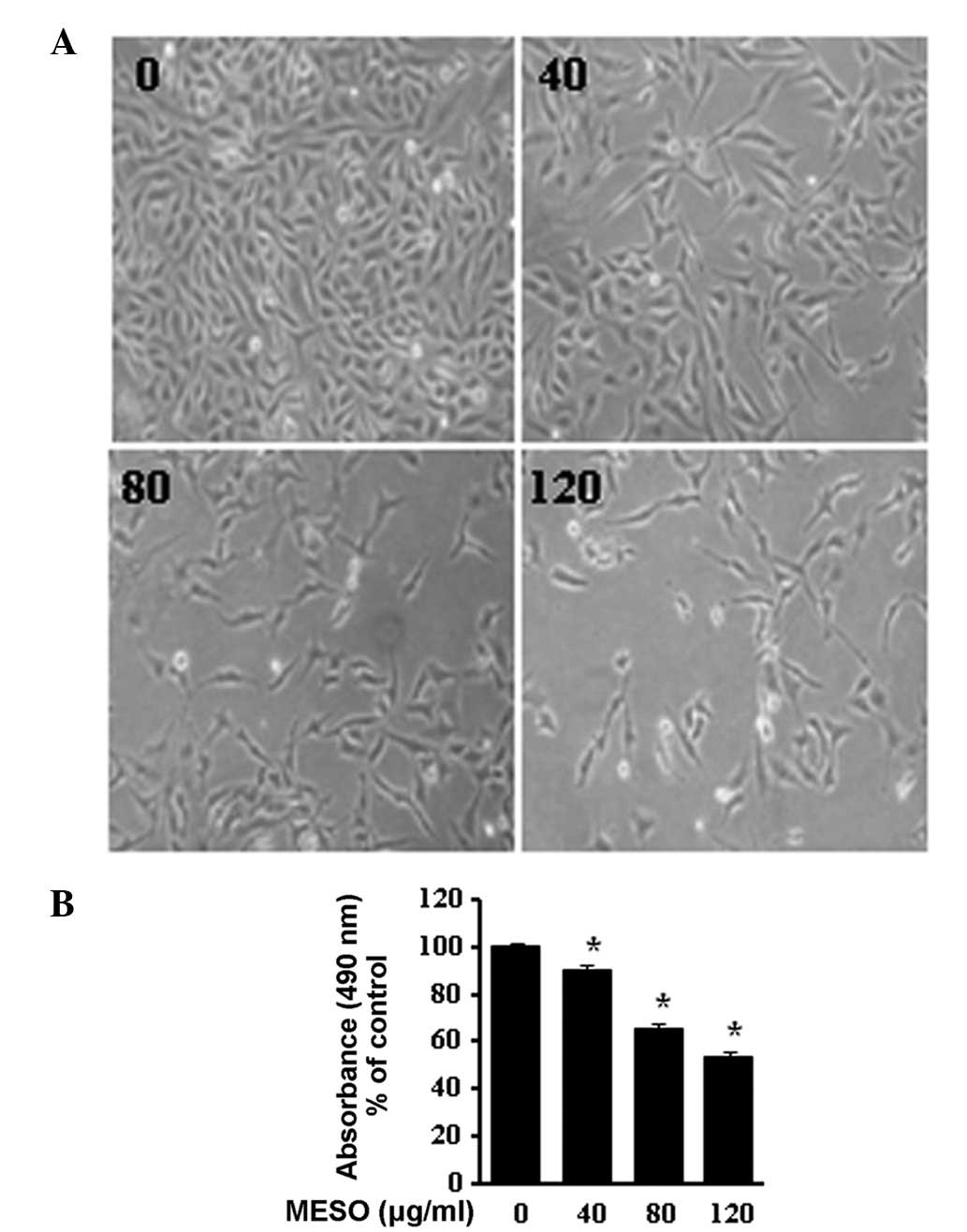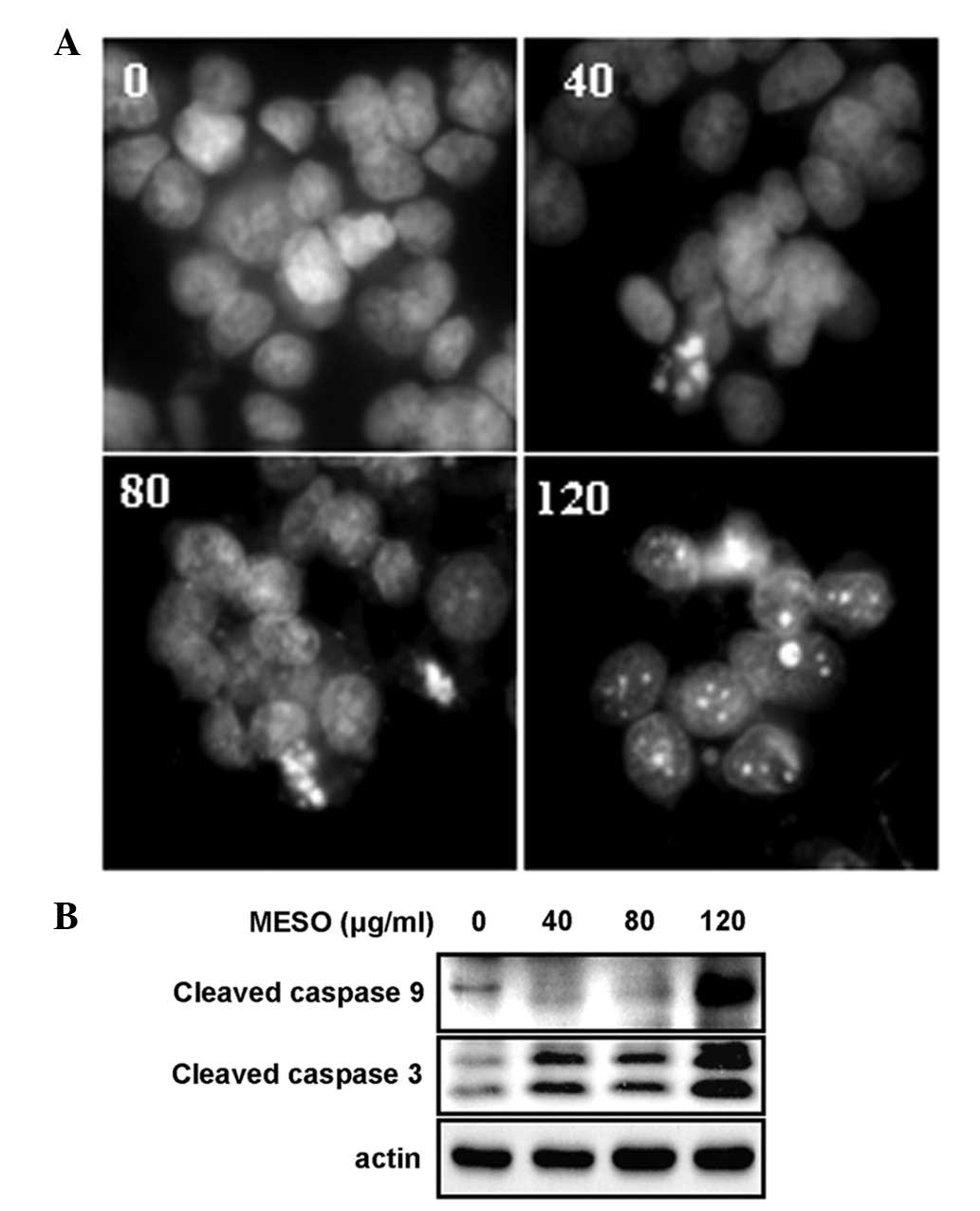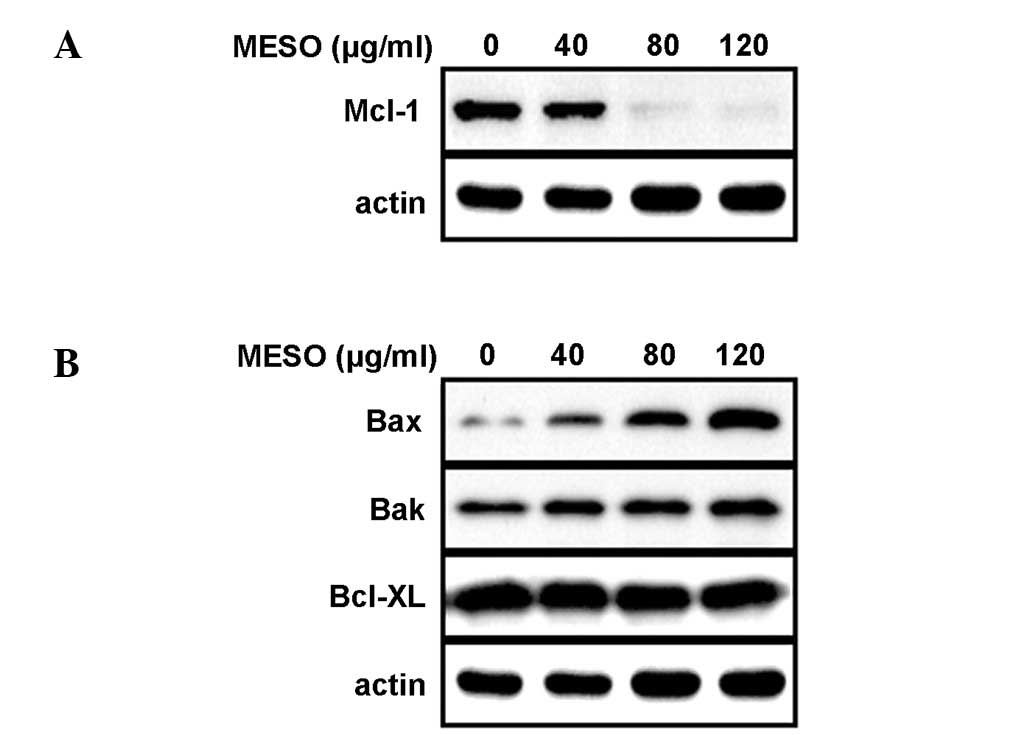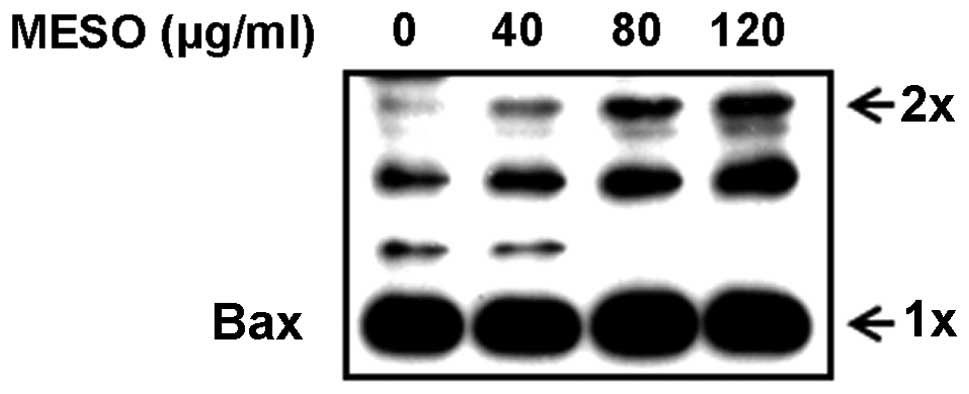|
1
|
Dayyani F, Gallick GE, Logothetis CJ and
Corn PG: Novel therapies for metastatic castrate-resistant prostate
cancer (Review). J Natl Cancer Inst. 103:1665–1675. 2011.
View Article : Google Scholar : PubMed/NCBI
|
|
2
|
Eisermann K, Tandon S, Bazarov A, Brett A,
Fraizer G and Piontkivska H: Evolutionary conservation of zinc
finger transcription factor binding sites in promoters of genes
co-expressed with WT1 in prostate cancer. BMC Genomics. 9:3372008.
View Article : Google Scholar : PubMed/NCBI
|
|
3
|
Kaur M and Agarwal R: Transcription
factors: molecular targets for prostate cancer intervention by
phytochemicals (Review). Curr Cancer Drug Targets. 7:355–367. 2007.
View Article : Google Scholar : PubMed/NCBI
|
|
4
|
Bardia A, Platz EA, Yegnasubramanian S, De
Marzo AM and Nelson WG: Anti-inflammatory drugs, antioxidants, and
prostate cancer prevention (Review). Curr Opin Pharmacol.
9:419–426. 2009. View Article : Google Scholar : PubMed/NCBI
|
|
5
|
Akgul C: Mcl-1 is a potential therapeutic
target in multiple types of cancer (Review). Cell Mol Life Sci.
66:1326–1336. 2009. View Article : Google Scholar : PubMed/NCBI
|
|
6
|
Tang H, Shao H, Yu C and Hou J: Mcl-1
downregulation by YM155 contributes to its synergistic anti-tumor
activities with ABT-263. Biochem Pharmacol. 82:1066–1072. 2011.
View Article : Google Scholar : PubMed/NCBI
|
|
7
|
Zhang Z, Yang H, Wu G, Li Z, Song T and Li
XQ: Probing the difference between BH3 groove of Mcl-1 and Bcl-2
protein: Implications for dual inhibitors design. Eur J Med Chem.
46:3909–3916. 2011. View Article : Google Scholar : PubMed/NCBI
|
|
8
|
Warr MR and Shore GC: Unique biology of
Mcl-1: therapeutic opportunities in cancer (Review). Curr Mol Med.
8:138–147. 2008. View Article : Google Scholar : PubMed/NCBI
|
|
9
|
Takahashi H, Chen MC, Pham H, et al:
Baicalein, a component of Scutellaria baicalensis, induces
apoptosis by Mcl-1 down-regulation in human pancreatic cancer
cells. Biochim Biophys Acta. 1813:1465–1474. 2011.
|
|
10
|
Chen W, Bai L, Wang X, Xu S, Belinsky SA
and Lin Y: Acquired activation of the Akt/cyclooxygenase-2/Mcl-1
pathway renders lung cancer cells resistant to apoptosis. Mol
Pharmacol. 77:416–423. 2010. View Article : Google Scholar : PubMed/NCBI
|
|
11
|
Wei SH, Dong K, Lin F, et al: Inducing
apoptosis and enhancing chemosensitivity to gemcitabine via RNA
interference targeting Mcl-1 gene in pancreatic carcinoma cell.
Cancer Chemother Pharmacol. 62:1055–1064. 2008. View Article : Google Scholar : PubMed/NCBI
|
|
12
|
Schulze-Bergkamen H, Fleischer B,
Schuchmann M, et al: Suppression of Mcl-1 via RNA interference
sensitizes human hepatocellular carcinoma cells towards apoptosis
induction. BMC Cancer. 6:2322006. View Article : Google Scholar
|
|
13
|
Guoan X, Hanning W, Kaiyun C and Hao L:
Adenovirus-mediated siRNA targeting Mcl-1 gene increases
radiosensitivity of pancreatic carcinoma cells in vitro and in
vivo. Surgery. 147:553–561. 2010. View Article : Google Scholar : PubMed/NCBI
|
|
14
|
Bredholt T, Dimba EA, Hagland HR, et al:
Camptothecin and khat (Catha edulis Forsk.) induced distinct
cell death phenotypes involving modulation of c-FLIPL, Mcl-1,
procaspase-8 and mitochondrial function in acute myeloid leukemia
cell lines. Mol Cancer. 8:1012009.PubMed/NCBI
|
|
15
|
Kim YI, Park SW, Choi IH, Lee JH, Woo HJ
and Kim Y: Effect of Orostachys japonicus on cell growth and
apoptosis in human hepatic stellate cell line LX2. Am J Chin Med.
39:601–613. 2011.
|
|
16
|
Lee NH, Lee MY, Lee JA, et al:
Anti-asthmatic effect of Sanguisorba officinalis L. and
potential role of heme oxygenase-1 in an ovalbumin-induced murine
asthma model. Int J Mol Med. 26:201–208. 2010.
|
|
17
|
Cho JY, Yoo ES, Cha BC, Park HJ, Rhee MH
and Han YN: The inhibitory effect of triterpenoid glycosides
originating from Sanguisorba officinalis on tissue factor
activity and the production of TNF-alpha. Planta Med. 72:1279–1284.
2006. View Article : Google Scholar : PubMed/NCBI
|
|
18
|
Goun EA, Petrichenko VM, Solodnikov SU, et
al: Anticancer and antithrombin activity of Russian plants. J
Ethnopharmacol. 81:337–342. 2002. View Article : Google Scholar : PubMed/NCBI
|
|
19
|
Ma Y, Zhang A, Shi Z, et al: A
mitochondria-mediated apoptotic pathway induced by deoxynivalenol
in human colon cancer cells. Toxicol In Vitro. 26:414–420. 2012.
View Article : Google Scholar : PubMed/NCBI
|
|
20
|
Wang X, Zhang F, Yang L, et al: Ursolic
acid inhibits proliferation and induces apoptosis of cancer cells
in vitro and in vivo. J Biomed Biotechnol. 2011:4193432011.
View Article : Google Scholar : PubMed/NCBI
|
|
21
|
Chen XR, Lu R, Dan HX, et al: Honokiol: a
promising small molecular weight natural agent for the growth
inhibition of oral squamous cell carcinoma cells. Int J Oral Sci.
3:34–42. 2011. View Article : Google Scholar : PubMed/NCBI
|
|
22
|
Wang Y, Deng L, Zhong H, Jiang X and Chen
J: Natural plant extract tubeimoside I promotes apoptosis-mediated
cell death in cultured human hepatoma (HepG2) cells. Biol Pharm
Bull. 34:831–838. 2011. View Article : Google Scholar : PubMed/NCBI
|
|
23
|
Chun JY, Tummala R, Nadiminty N, et al:
Andrographolide, a herbal medicine, inhibits interleukin-6
expression and suppresses prostate cancer cell growth. Genes
Cancer. 1:868–876. 2010. View Article : Google Scholar : PubMed/NCBI
|
|
24
|
Lin YH, Chen KK and Chiu JH:
Coprescription of Chinese herbal medicine and western medications
among prostate cancer patients: a population-based study in Taiwan.
Evid Based Complement Alternat Med. 2012:1470152012.PubMed/NCBI
|
|
25
|
Wang Z, Loo WT, Wang N, Chow LW, Wang D,
Han F, Zheng X and Chen JP: Effect of Sanguisorba
officinalis L. on breast cancer growth and angiogenesis. Expert
Opin Ther Targets. 16(Suppl 1): S79–S89. 2012.
|
|
26
|
Quinn BA, Dash R, Azab B, et al: Targeting
Mcl-1 for the therapy of cancer (Review). Expert Opin Investig
Drugs. 20:1397–1411. 2011. View Article : Google Scholar : PubMed/NCBI
|
|
27
|
Dash R, Azab B, Quinn BA, et al:
Apogossypol derivative BI-97C1 (Sabutoclax) targeting Mcl-1
sensitizes prostate cancer cells to mda-7/IL-24-mediated toxicity.
Proc Natl Acad Sci USA. 108:8785–8790. 2011. View Article : Google Scholar : PubMed/NCBI
|
|
28
|
Senft D, Berking C, Graf SA, Kammerbauer
C, Ruzicka T and Besch R: Selective induction of cell death in
melanoma cell lines through targeting of Mcl-1 and A1. PLoS One.
7:e308212012. View Article : Google Scholar : PubMed/NCBI
|
|
29
|
Shimazu T, Degenhardt K, Nur-E-Kamal A, et
al: NBK/BIK antagonizes MCL-1 and BCL-XL and activates BAK-mediated
apoptosis in response to protein synthesis inhibition. Genes Dev.
21:929–941. 2007. View Article : Google Scholar : PubMed/NCBI
|
|
30
|
Dewson G and Kluck RM: Mechanisms by which
Bak and Bax permeabilise mitochondria during apoptosis. J Cell Sci.
122:2801–2808. 2009. View Article : Google Scholar : PubMed/NCBI
|
|
31
|
Kim H, Rafiuddin-Shah M, Tu HC, et al:
Hierarchical regulation of mitochondrion-dependent apoptosis by
BCL-2 subfamilies. Nat Cell Biol. 8:1348–1358. 2006. View Article : Google Scholar : PubMed/NCBI
|
|
32
|
Clohessy JG, Zhuang J, de Boer J,
Gil-Gómez G and Brady HJ: Mcl-1 interacts with truncated Bid and
inhibits its induction of cytochrome c release and its role in
receptor-mediated apoptosis. J Biol Chem. 281:5750–5759. 2006.
View Article : Google Scholar : PubMed/NCBI
|
|
33
|
Adams JM and Cory S: Bcl-2-regulated
apoptosis: mechanism and therapeutic potential (Review). Curr Opin
Immunol. 19:488–496. 2007. View Article : Google Scholar : PubMed/NCBI
|
|
34
|
Mitchell C, Yacoub A, Hossein H, et al:
Inhibition of MCL-1 in breast cancer cells promotes cell death in
vitro and in vivo. Cancer Biol Ther. 10:903–917. 2010. View Article : Google Scholar : PubMed/NCBI
|
|
35
|
Ménoret E, Gomez-Bougie P, Surget S, et
al: Mcl-1(128–350) fragment induces apoptosis through direct
interaction with Bax. FEBS Lett. 584:487–492. 2010.
|
|
36
|
Jiang CC, Wroblewski D, Yang F, Hersey P
and Zhang XD: Human melanoma cells under endoplasmic reticulum
stress are more susceptible to apoptosis induced by the BH3 mimetic
obatoclax. Neoplasia. 11:945–955. 2009.PubMed/NCBI
|
|
37
|
van Delft MF and Huang DC: How the Bcl-2
family of proteins interact to regulate apoptosis (Review). Cell
Res. 16:203–213. 2006.PubMed/NCBI
|
|
38
|
Adams JM: Ways of dying: multiple pathways
to apoptosis. Genes Dev. 17:2481–2495. 2003. View Article : Google Scholar : PubMed/NCBI
|
|
39
|
Green DR and Kroemer G: The
pathophysiology of mitochondrial cell death (Review). Science.
305:626–629. 2004. View Article : Google Scholar
|
|
40
|
Chu R, Upreti M, Ding WX, Yin XM and
Chambers TC: Regulation of Bax by c-Jun NH2-terminal kinase and
Bcl-xL in vinblastine-induced apoptosis. Biochem Pharmacol.
78:241–248. 2009. View Article : Google Scholar : PubMed/NCBI
|
|
41
|
Qanungo S, Das M, Haldar S and Basu A:
Epigallocatechin-3-gallate induces mitochondrial membrane
depolarization and caspase-dependent apoptosis in pancreatic cancer
cells. Carcinogenesis. 26:958–967. 2005. View Article : Google Scholar
|
|
42
|
Zhao L, He F, Liu H, et al: Natural
diterpenoid compound elevates expression of Bim protein, which
interacts with antiapoptotic protein Bcl-2, converting it to
proapoptotic Bax-like molecule. J Biol Chem. 287:1054–1065. 2012.
View Article : Google Scholar : PubMed/NCBI
|













